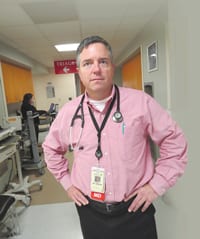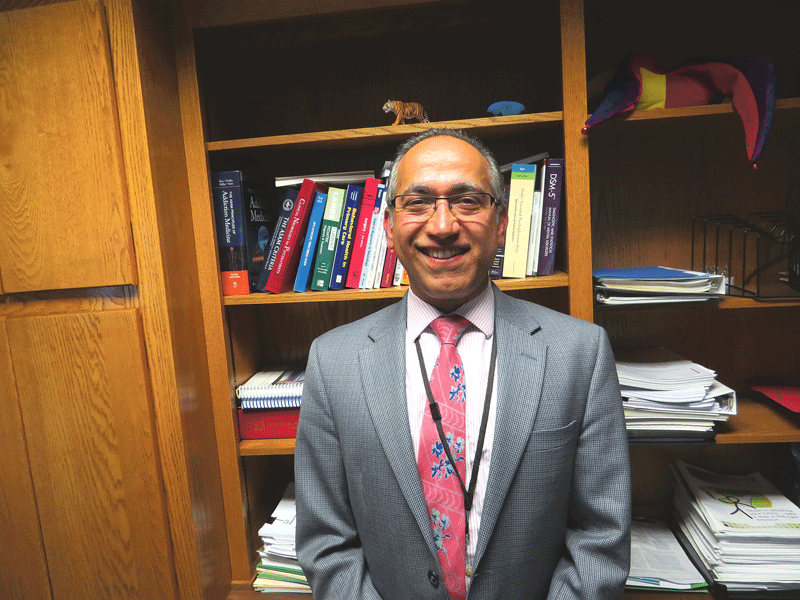On the Front Lines of a Crisis – ERs Grapple with the Many Aspects of the Opioid Epidemic
Dr. Niels Rathlev says it was maybe a year ago that he started hearing, anecdotally, that the emergency room at Baystate Medical Center was rumored to be a place where a visitor could quite easily get some prescription pain meds — if they were so inclined.
Fast-forward to just a few months ago, when, he noted with noticeable pride in his voice, he heard — this time directly from people who were so inclined — that this was no longer the case.
“We actually overheard a couple of people in a back hallway here talking,” said Rathlev, chair of the Department of Emergency Medicine at Baystate. “They were saying that it’s much more difficult to get opioids from the doctors here.”
This significant change in dialogue about Baystate’s ER — and the reasons behind it — speak volumes about the many ways in which the ongoing opioid crisis is impacting life in area emergency departments, which are, in many ways, the front lines in this battle, and how they are responding to this epidemic.
The most visible, or news-making, aspect of this crisis and the way it’s affecting ERs is the alarmingly high number of heroin-overdose cases reported across the region. Since last fall, BMC is averaging at least one case a day, and often there are several, said Rathlev, adding that, thanks to naloxone, a medication sold under the brand name Narcan, among others, many of those who overdose can be saved. Still, some do not arrive in time to be revived, he went on, as almost weekly reports from area media outlets make clear.
When asked how many have died, he said simply, “I don’t have a number … obviously, too many.”
But heroin overdoses represent just the proverbial tip of the iceberg with the opioid crisis, said Dr. Louis Durkin, an emergency medicine physician at Mercy Medical Center, noting that there are many manifestations of this problem that are far less headline-grabbing, but nonetheless concerning.
This is especially true of addiction to prescription pain medications, which for years has revealed itself in individuals with chronic pain wandering from ER to ER looking for a prescription to Percocet, OxyContin, or myriad other drugs — and, until recently, having generally good luck obtaining one.
It’s certainly not a new problem; Durkin says he’s dealt with it throughout his 20 years as an emergency-room doctor. But it’s one that has grown in scope because of the manner in which those drugs were prescribed — and over-prescribed — for years, leaving people addicted to them and often desperate to get them.
“We see far more people with opioid issues, especially addiction, than we do with opioid overdoses,” he explained. “And we’ve been working very hard over the past five or six years to mitigate that, because this is clearly a high-risk group for overdoses.”
Indeed, hospitals like Baystate and Mercy have responded with comprehensive programs — greatly assisted by the state Prescription Monitoring Program (PMP), established in 2010 — that identify frequent visitors to ERs, and especially those who come in search of painkillers.
“We look at patients who are high-frequency users of ED services, and that is a pretty good screen, at least to begin with, and we track them,” Rathlev explained. “If you see someone who has been here 50 times in a year, that’s a good indicator.”
Such information is shared among the hospitals, said Durkin, adding that Mercy has a similar registry, if you will. There are now roughly 600 names on it, he went on, noting that care plans are developed for such individuals with the goal of treating their pain and reducing their risk of an opioid overdose.
In many ways, the region’s ERs serve as a microcosm of the opioid crisis — from the way it has permeated every region of the state, urban and rural, to the many ways the epidemic manifests itself; from the frustration that comes from reviving an overdose victim, only to see that individual back in the ER — or the morgue — just days later, to clear uncertainty about whether the crisis has peaked or is still getting progressively worse.
For this issue and its focus on healthcare, HCN spoke with several ER administrators about the many faces of this crisis and how, in many ways, the ER has become ground zero in a war with many fronts.
Doses of Reality
Dr. Rakesh Talati says Greenfield is like many rural communities stung by the opioid epidemic — only there are some unique circumstances that make the situation there even worse.
Indeed, this city of 18,000 people sits right on I-91, the major north-south corridor for heroin trafficking, and is only a few miles from the Vermont border, where the opioid problem is especially acute, and a shortage of supply has prompted many entrepreneurial-minded individuals to energetically attempt to meet demand.
That makes heroin readily accessible and usually quite cheap, said Talati, chair of the Emergency Department at Baystate Franklin Medical Center (BFMC), adding that all this has also made it extremely, and alarmingly, popular.
“Our younger population seems to be using it quite a bit — heroin is the dangerous drug of choice in our area,” he said. “The problem is probably as prevalent here as it is in Springfield or Holyoke, because we’re just another stop off 91.”
Baystate Franklin sees only a fraction of the overdose cases that the Springfield-based hospitals do (maybe one a week) because it serves a wide but sparsely populated area, said Talati, but it handles its share, partly due to the aforementioned accessibility of heroin, but also because this is the only hospital in Franklin County, and those from the area who have overdosed can’t easily drive past it to get treatment somewhere else, which an individual might do if he or she lived in Northampton, Holyoke, or Westfield, also homes to community hospitals.
“When it’s 40 minutes to the next hospital, or to Springfield, people have a tendency to stop here,” he said, adding that this is also why the hospital sees a comparatively large number of stroke and heart-attack patients for its size. “We’re essentially the one shop in town, so we have to be ready for anything.”
This same geographic characteristic certainly limits the options for those seeking prescription painkillers, he went on, adding that BFMC sees every aspect of the opioid problem.
And none of the them would qualify as recent phenomena, he stressed repeatedly, adding that heroin overdoses and patients coming to the ER in quest of powerful painkillers are problems addressed by generations of ER doctors.
But the scope of the problem continues to escalate, said Talati and the others we spoke with, noting that, while the huge amount of attention given the problem on the regional, state, and federal levels has certainly raised awareness of the issue, recent numbers would indicate that progress is elusive.
That is especially true when it comes to heroin overdoses, said Rathlev, adding that, while the effectiveness and improved accessibility of naloxone — one can now get it at Baystate’s pharmacy, for example, with only a $4 co-pay — have certainly made a difference when it comes to saving the lives of those who have overdosed, the number of cases continues to escalate, as does the number of deaths.
Quantifying the matter as best he could, Rathlev said Baystate saw roughly 150 overdose cases in the fiscal year that ended last Sept. 30. But in the first two months of the new year, it saw 109, and is on pace to more than double last year’s total and approach one case per day on average, with perhaps 60{06cf2b9696b159f874511d23dbc893eb1ac83014175ed30550cfff22781411e5} of those cases involving men ages 15-30.
“Whether that was a blip, we don’t know,” he said of the start of the new fiscal year, “but we nearly tripled the rate of the year before for that same time period, and that is certainly concerning.”
Durkin agreed, and said there are many reasons for this rise, including those aforementioned efforts by all ERs — and the medical community in general — to curb the availability of prescription opioids.
“People are switching to heroin because it’s cheap and its available,” he noted, adding quickly that, nationally, overdoses of prescription opioids are still nearly three times as common as those involving heroin — roughly 28,000, compared to about 10,000.
Another reason for the rise in heroin overdoses is the potency of the products now being found on the streets. Some shipments, such as the highly publicized batches of ‘Hollywood’-stamped heroin that reached the area late last year, are quite lethal, he said.
But perhaps the biggest problem, he continued, is that users simply don’t know what they’re getting when they make a buy.
“The problem with an illicit drug is there’s no control,” he explained, “so the potency can vary by orders of magnitude — one batch can be 10 to 100 times more potent than another batch.”
Meanwhile, treating heroin overdoses is only part of the story, said Talati, adding that what happens after a patient is revived is becoming a growing source of frustration among ER personnel.
Such individuals require counseling, detox, and medication-assisted therapy, or MAT, meaning methadone or Suboxone, among other treatments for opioid dependency.
Often, they leave the ER and the hospital without any of the above, because they don’t want it or it’s not available.
“The majority of the patients that overdose on heroin that we revive are uninterested in treatment at that time and just want to go home, and they range in vocalness and belligerency concerning that,” he explained. “Addiction is a very difficult disease, and when they’re right in the midst of that addiction, even a near-death experience isn’t enough to shake them at that moment.”
Often, even for those who are shaken, securing proper treatment can be a challenge.
“What we really struggle with in the ER is that we can stabilize the patient, but then, if they want treatment, getting them into a center is not as easy as it should be,” said Talati. “So, oftentimes, we can’t get them the treatment they want.”
Bitter Pills
As Durkin noted, heroin overdoses represent only the tip of the iceberg with this crisis. Equally alarming is that problem of addiction to prescription painkillers, and efforts to use ERs as a dispensary.
Many chronic pain sufferers resort to the ER because, in most cases, there are few, if any, other options, he said, adding that many have essentially fired their primary-care physician — or been fired by that doctor — because they can’t get want they want there.
And what they’re finding, a trend verified by that conversation Rathlev overheard in the hallway, is that it is now increasingly difficult to obtain what they need in the ER, because those facilities are far more careful about how they dispense such medications.
The state PMP, which collects dispensing information on certain controlled substances, puts information in the hands of ER physicians, who then use it in efforts to control prescription drug abuse.
To explain the problem, and how ERs have responded, Rathlev cited a case that is in many ways typical of what ER doctors see on a regular basis.
“This was a young man who complained of back pain, and he had this pain for quite some time,” he told HCN. “As I recall, he had seen an orthopedic surgeon, and surgery was either scheduled or had been postponed, and now he was in a lot of pain.
“Initially, I was prepared to give him opioids because he appeared to be in a lot of pain,” he went on. “As things unfolded, I checked with the PMP, I looked at his medical records, and I then called his primary-care physician, who said, ‘this is actually an issue for this patient, and you should be really careful what you prescribe.’ I think I did give him one dose of morphine, but I didn’t given him anything after that.”
Elaborating, Rathlev said incidents like this one — and the numbers of them are not declining — turn ER doctors into “sleuths” as they treat pain-related cases that come before them.
And, while such work is necessary, it is at times difficult because it collides head-on with any physician’s primary mission — to ease the pain and suffering of their patients.
“Our attitude is to try limit our prescribing as much as possible,” said Baystate Franklin’s Talati. “But we don’t want to swing in a direction so that some patient with true pain doesn’t get treated for that pain, either.
“It’s a very difficult thing to figure out sometimes,” he went on, adding that one compounding factor is the lack of quality dental care in some low-income populations, which often causes chronic pain — a problem prevalent in Franklin County.
Meanwhile, the new protocols can also lead to some stressful moments, said Durkin, adding that, while more patients seemingly understand why the ER doctor says ‘no’ when they ask for a painkiller, that is not the answer they are looking for.
“There are some very, very angry patients,” he explained. “It can be a difficult conversation, but it can be very rewarding, too, when you get someone into a better, safer place. But it’s not easy; it’s a challenge, and it’s going to be a challenge for a long time.”
Prescription for Progress?
When asked if the medical community, and society in general, had turned any kind of corner with regard to the opioid crisis, those we spoke with all expressed a desire to be optimistic, and to a large extent, they are. But they clearly conveyed the message that anything approaching real progress is still far off.
“I think we’ve hit the peak and are probably on our way down from the prescription-opioid problem — I think there’s now enough support for providers to try to limit, control, and decrease the amount of prescriptions we’re giving, which we didn’t have 10 years ago,” said Durkin. “A decade ago, the culture would be that, if a patient complained that you were not giving them pain medication, you’d be fired as a physician. Now, there’s much more support to limit the amount of prescribing.
“The problem, however, is that we have an incredible number of opioid-dependent people out there that we need to get into treatment, or they’ll turn to heroin,” he went on. “That aspect of the problem will continue to grow until we get a real handle on it.”
Talati agreed, and said there are many aspects of this crisis that would lead him to conclude that it has not peaked yet.
“The thing that concerns me is the age of the people we’re seeing who are using heroin and overdosing on it — people in their teens and early 20s,” he explained. “This means that the education for this has to be for preteens, and that’s a real challenge. Meanwhile, there’s a virtually unlimited supply of cheap, high-quality heroin, and until we can do something about that, it’s clear that we’re not going to make much progress.”
What is also clear is that the region’s ERs will continue to constitute the front lines in this fight, and they will continue to respond imaginatively and responsibly to a crisis defined by a host of stern challenges.




